This is a Voigtländer Vitomatic IIa 35mm rangefinder camera made by Voigtländer from 1960 to 1964. The Vitomatic IIa was a compact but very heavy camera that packed quite a bit of features into such a small body. It had a coupled selenium cell exposure meter with a match needle that was visible both on the top plate of the camera and within the viewfinder using a clever setup of mirrors. The shutter speed and aperture rings were coupled together which would prevent selection of settings outside of the camera’s capability. It also had a neat wind knob that would automatically put the camera into rewind mode when it was raised. Perhaps it’s most noticeable feature is the huge viewfinder which was made out of a single piece of crystal making it extremely appealing to users wearing prescription glasses. The camera was very well built and has proven to be reliable over the years as many still work.
Film Type: 135 (35mm)
Lens: 50mm f/2.8 Color-Skopar coated 4-elements
Focus: 3.5 Feet to Infinity
Viewfinder: Coincident Image Rangefinder with 50mm Projected Brightlines
Shutter: Prontor SLK-V Leaf
Speeds: B, 1 – 1/500 seconds
Exposure Meter: Coupled Selenium Cell w/ Top Plate and Viewfinder Match Needle
Battery: none
Flash Mount: Coldshoe and PC port MXV-sync
Manual: http://www.cameramanuals.org/voigtlander_pdf/voigtlander_vitomatic_iia.pdf
History
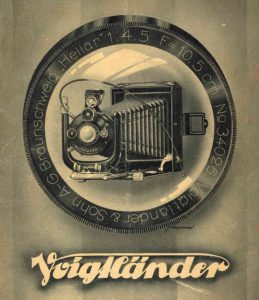
Voigtländer is the world’s oldest optics company, with a history dating back to the 1700s. I spent an unnecessarily large amount of time covering their history in my review for the Vito II so rather than repeat a large amount of that information here, I encourage you to read the first part of the Vito review if you want to know more. For this review, I’ll skip to the beginning of the 20th Century when Voigtländer showed significant interest in building their own cameras, rather than just primarily being a lens maker.
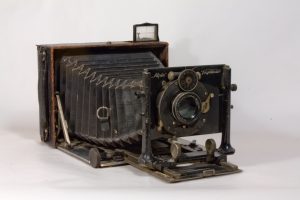
As film photography would gain momentum in the 1900s with models from the Eastman Kodak company and other German makers, Voigtländer started to make a more serious effort into designing their own cameras. In the first two decades of the 20th century, the company would release a wide range of folding plate cameras with names such as Scheren-Camera, Alpin, Stereophotoskop, and Avus.
Voigtländer had great success around this time as both a maker of fine plate cameras and lenses. In 1915, the company would outgrow it’s original factory in Braunschweig and would move to a larger facility on the other side of the town. As Voigtländer gained experience making cameras over the next decade, they would experiment with other designs, such as Single Lens Reflex and roll film cameras.
I reviewed an early Voigtländer roll film camera from 1927 called the Rollfilm here, and found it to be a well built, but basic camera capable of really nice shots. Many of Voigtländer’s other roll film designs such as the Avus and Bessa had higher spec shutters and lenses and compared favorably to those made by other German companies like Zeiss-Ikon, Certo, and Nagel.
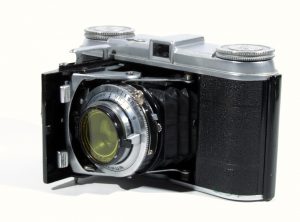
Throughout most of the 1930s, Voigtländer would mainly stick to medium format roll film cameras like the Bessa, the Perkeo, and the Inos. The company would be one of the last German companies to release a ‘miniature’ camera using the new 35mm format which was popularized by Leitz, Zeiss-Ikon, and Kodak. Many other German camera makers such as Balda, Welta, and Ciro would all have competing 35mm models before Voigtländer’s first 35mm model, the Vito which was released in 1939. The first Vito was designed for unperforated 35mm cinema film and made 30mm x 40mm exposures. This original Vito was made only for a short time in 1939 and early 1940 until production was halted due to the start of World War II.
It wouldn’t be until 1947 that Voigtländer would resume production of the Vito. By this time, the source for the original model’s unperforated film was no longer in business, so the camera had to be redesigned with a feeler shaft to accept perforated 35mm cinema film loaded in special canisters. While not specifically designed for Kodak’s 135 format 35mm film, this article by John Margetts suggests that a regular Kodak 135 cassette fits fine on both the take up and supply sides of the camera. The Vito would eventually be redesigned to use regular 35mm film and would go through several revisions over the next two decades. The name “Vito” would be a mainstay in Voigtländer’s lineup until the early 1970s representing both their high and low end spectrum of cameras.
In 1954, the folding Vito would be replaced by a solid bodied model called the Vito B. The Vito B would retain most of the same complement of features as the folding variant but would have an all new body. From 1954 – 1957, the Vito B would have a small viewfinder that was comparable to similar 35mm cameras by other manufacturers, but in 1958, a revised model called the Vito BL would receive an upgraded viewfinder that was much larger than anything on the market at the time. The large viewfinder was reportedly made out of a single, solid piece of crystal and offered a 1:1 ratio image that allowed a photographer to shoot with both eyes open. At the same time as the BL’s release, a variant called the Vitomatic was released that added a coupled selenium cell light meter. The Vitomatic came in either a viewfinder only configuration, known as the Vitomatic I, or with a rangefinder, known as the Vitomatic II.
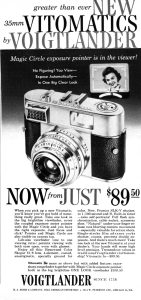
In 1960, the Vitomatics Ia and IIa were released with two pretty significant upgrades. The first, was a revised shutter that increased the top speed from 1/300 to 1/500, but the second was a clever viewfinder mirror which allowed the user to see the match needle system from within the viewfinder. This allowed the user to constantly monitor the meter reading from within the viewfinder while composing an image without having to pull their eye away from the camera. The Vitomatic IIa has the distinction of being the very first camera with an integrated match needle meter readout that was visible within the viewfinder. The IIa was also the best selling of all Vitomatic models by a wide margin. According to the book Voigtländer Report by Claus Prochnow, around 200,000 IIas were sold. These figures are especially impressive considering these were not inexpensive cameras. The ad to the left from the September 1960 issue of Modern Photography lists the price of both the Vitomatic Ia and IIa as $89.50 and $109.50, which when adjusted for inflation is comparable to $736 and $901 in 2017.
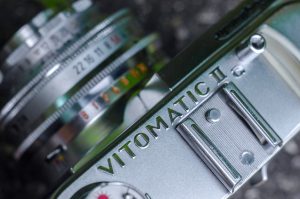
Although most Vitomatic Ia and IIas had the 4-element f/2.8 Color-Skopar lens, about 6500 IIas were offered with the 6-element f/2 Ultron lens. The Ultron variants are quire rare and very expensive when they show up for sale today. Both the Ia and IIa would stay in production for 4 years before finally being replaced by the Vitomatic Ib, IIb, and IIIb. The ‘b’ Vitomatics had an all new body design with a simpler shutter release system. By this time, cost cutting at Voigtländer saw several features disappear such as the top meter readout, and a downgrade to the focusing system.
Four years later, the last of the Vitomatics would be released known as the ‘CS’ models that had a battery powered CdS meter instead of the battery-less selenium meter. Despite being in production for nearly 5 years, the CS series would be the poorest selling of all the Vitomatic cameras, with less than 25,000 sold during the entire production run.
Throughout the Vitomatic’s 14 year lifespan, the IIa would not only be the series’s best selling model, with over 200,000 made between 1961 to 1963, but it would offer the best balance of features, excellent build quality, and good looks.
Today, the Vitomatic series isn’t a particularly sought after model, as other Voigtländer models like the Bessa, Prominent, and Vitessa rank much higher on collector’s wish lists, but for those fortunate enough to try out a Vitomatic, they are very highly regarded. The Vitomatic IIa is a really nice looking camera that when equipped with the “regular” Color-Skopar lens, is capable of excellent shots. The match needle visible in the viewfinder was an innovative feature and when combined with the larger than life viewfinder, makes shooting both easy and pleasurable.
My Thoughts
Rangefinder cameras were the bread and butter of the photography industry from the 1930s through the 50s, but by the time the 1960s had started, the Single Lens Reflex camera had become the preferred design for the professional photographer. Even for the advanced amateur, less expensive models by Asahi Pentax, Miranda, and Minolta were becoming common. For the companies still making rangefinders in the 1960s, some compromises had to be made. Most would have a fixed lens, and would come in a more compact body, with simpler features like selenium light meters, light value scales, and easier to use controls.
While many Japanese companies were releasing new SLR models every few months, many German companies like AGFA, Zeiss-Ikon, and Voigtländer would stick with the rangefinder design, and continued to release new lines of quasi-entry level cameras still built to a high quality standard. Many of these 1960s German rangefinder cameras had a similar squared look with large and bright viewfinders, leaf shutters, and ~50mm prime lenses topping out with a maximum aperture of f/2.8.
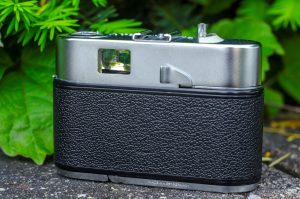
At one time I owned a Zeiss-Ikon Contessamatic which was very similar to the Vitomatic, but I never took the time to shoot it. When I saw this Voigtländer Vitomatic IIa for sale at a local thrift shop for the low, low price of $10, I wasn’t initially that interested in yet another low end scale focus camera. What changed my mind though, was the monster viewfinder this thing had. I’ve often talked about how I struggle with the minuscule viewfinders that were on early 20th century cameras due to my poor vision and prescription glasses, but one look through the viewfinder, and I knew I needed to give it a chance.
I’ll admit to knowing nothing about the Vitomatic series before picking up this camera. In fact, I didn’t even realize it had a rangefinder until after I got it home. Rangefinders were not very common in these square German cameras, and also working against it was that the coincident image rangefinder patch is awfully dim on this particular example. But a rangefinder it was, and my intrigue for it only grew.
Before taking the camera out for it’s inaugural roll, I had the thought to take the top plate off the camera and see if I could improve the dim rangefinder patch by cleaning it. On many cameras, a gentle cleaning of the mirrors and interior glass can improve contrast in the rangefinder. The Vitomatic has one of the easiest top plates of any camera to remove. There are a total of three screws, one on each side of the top plate, and a third on the back behind the wind lever which must be removed, and then the whole plate comes off. The wind lever and rewind knobs do not need to be touched, simplifying the process.
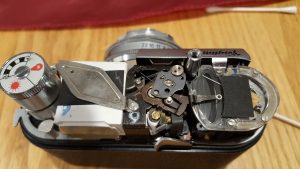
Unfortunately, after getting the top off, I quickly realized that there’s not much you can do under there. Unlike traditional rangefinder cameras that use a combination of mirrors and optical glass, the Vitomatic uses a huge cube shaped prism for the rangefinder and viewfinder. In the image to the right, the prism is the large white cube beneath the diamond shaped piece of metal next to the rewind knob. This prism is not serviceable at all, and any attempt to remove it or take it apart would likely be disastrous. Since the camera was in otherwise good working shape, I just put it back together without any additional work.
Beyond the larger than life viewfinder, the second thing you’ll notice if you ever pick one of these up is how misleadingly heavy they are. This is a heavy camera! Weighing in at 737 grams, it weights almost as much as an Argus C3, a camera which has earned the nickname of “The Brick” due to its brick-like shape and weight.
After feeling the heft of the all metal Vitomatic for a few seconds, learning that it has a rangefinder, and seeing how truly monstrous that viewfinder was, I realized this was most definitely NOT a cheap, low end camera, but in fact, it was a rather beautifully designed camera with capable features and an interesting exposure system. I played with the camera a bit and was thrilled to discover that the camera was in nearly perfect working order. Other than a slightly dim rangefinder patch, everything else on the camera worked perfectly, even the slow shutter speeds. The Vitomatic pre-dates the use of foam light seals that became common later in the 1960s and into the 70s, so I didn’t even need to replace those.
Normally I would attempt to keep you in suspense regarding my impressions of a camera, but I discovered almost immediately after using the camera that I loved using it. The Vitomatic IIa is a joy to use. If you are a fan of “quirks” in a camera, the Vitomatic has quite a few of them that add to the appeal of the camera.
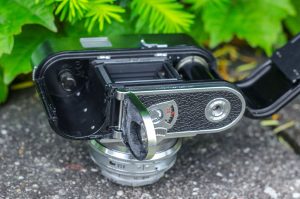
The first quirk you’ll encounter is while loading your first roll of film. The Vitomatic IIa has a hinged back like many cameras of the day, but unlike many cameras of the day, it is hinged on both the side and the bottom. There is a smaller door on the bottom of the camera that must be opened before you can open the rest of the back. To open this smaller door, you must pull out a base plate latch and twist it 90 degrees while pulling on it. Upon pulling this latch, the bottom door will swing open, which simultaneously unlocks the main door, which will then swing open like any other camera with a hinged door. Although strange at first, you’ll find that this makes loading film into the camera much easier as you don’t need to pull up on the rewind knob to make room for the new cassette. You simply slide it in from the bottom and thread the leader.
Installing a new film cassette is pretty typical of any 35mm camera, but according to page 4 of the Vitomatic’s user manual, they advise you to attach the film leader to the take up spool before inserting the cassette into it’s chamber. I know that many 35mm veterans employ this “leader first” method on all cameras, but it is not common for a manual to specifically tell you to do it this way. I am unsure if there is a practical reason for this, but it’s worth noting that Voigtländer thought it prudent enough to spell it out for you.
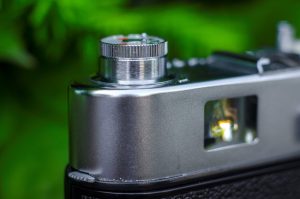
Once the cassette is in it’s chamber on the left side of the camera, the manual then advises you to engage the reversing lever, which is that little knurled tab on the left side of the camera. Doing this performs two functions, most obvious is that the rewind knob “pops” up, making it accessible to take up slack inside of the film cassette, but it also deactivates the sprocket wheel inside of the film compartment making it easier to thread the leader onto the take up spool.
After threading the leader onto the take up spool, you should give the rewind knob a couple of turns to take up slack inside of the cassette. Next, take one last look at the film leader and make sure it is properly engaged on the take up spool, then close the back of the camera. Close the big door first, and then the smaller door on the bottom to properly lock it. One the door is closed, push the rewind knob back into it’s “down” position until you hear a click, which returns the camera to normal “advance” mode. You must remember to do this, or else the film will not properly travel over the sprockets and onto the take up spool while winding.
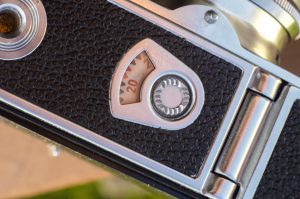
The next step is to reset the film exposure counter. The Vitomatic IIa does not have an automatic resetting exposure counter. It also counts backwards, like on most Kodak Retinas. This means you set the exposure counter to however many exposures are left on your roll, and as you take an image, it counts backwards down to 1. To rotate the exposure counter, you simply press in on the recessed dial and spin it. It spins both clockwise and counterclockwise, so you can move it in whichever direction gets you to the proper number quickest. For a 36 exposure roll, you set it to a red “F” that is next to the number 36. The camera has a red mark on the 22nd frame for a 20 exposure roll, but since 20 exposure rolls aren’t common anymore, if you wanted to use a 24 exposure roll, you would set it to the 26th frame. After setting the frame counter to either the red “F” or the 26th frame, wind and fire off 2 shots to get to your first real exposure. Winding the camera can be one in one single motion, or in multiple small motions, whichever you prefer. The counter should now be on either the numbers 36 or 24.
If you plan on using the meter on your Vitomatic, you’ll need to set the film speed. There are little windows on the side of the lens for ASA and DIN speeds. The camera supports ASA 12 – 800 and DIN 12 – 30. To change the speed, there is another knurled tab on the bottom of the lens, which looks similar to the reversing lever that you used to pop up the rewind knob. The knob that changes aperture size on the lens actually has two rings that under normal circumstances, rotate together. When changing film speeds, you need to press and hold the knurled tab on the lens while rotating the outer ring on this double ring. You’ll notice that when you do this, the numbers change in the small window, indicating your selected film speed.
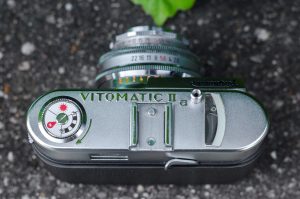
The metering system uses a “circle and post” match needle system. The meter itself is located on the top plate of the camera, seen in the image to the right. However, through a clever series of mirrors, light that enters through the meter, is reflected into the bottom part of the viewfinder prism so that you can see a mirror image of the meter while looking through the viewfinder. Since the meter relies on ambient light entering through the top of the camera, if you are shooting in low light, or if something is blocking the top plate, you won’t be able to see the meter through the viewfinder.

Whether you are looking at the meter through the viewfinder or the top plate of the camera, there are two needles, one with a circle on it, and one without. The one without the circle is connected to the light meter and will move to an arbitrary position depending on how much light is detected. The one with the circle is connected to both the aperture and shutter speed rings on the lens. Both rings are coupled using a Light Value System, very similar to the one used by Yashica on the Minister-D. Rotating this linked knob will move the needle with the circle and the object is to get both needles to line up. If the exposure needle is visible in the center of the circle, then you have proper exposure. If the exposure needle is too much to the left or right of the circle, you will either under or over exposure your image. I actually prefer this method to the more common + and – system found on cameras in the 70s and 80s as I feel it’s faster and gives you a more accurate view of how far off your exposure will be.
Of course, since the Vitomatic IIa is an entirely mechanical camera, you can disregard the needle altogether and just pick whatever combination of shutter speed and aperture you want. The LVS system is easy to defeat. You simply move whichever ring you want to get the arrows to lineup to whichever aperture or shutter setting you want. Shutter speeds 1 – 1/30 and B are in yellow to caution you to stabilize the camera to avoid camera shake. Everything 1/60 and above is black, indicating that handheld shots are OK.
The Vitomatic IIa is a rangefinder, so getting accurate focus is as easy as any other coincident image rangefinder. If however, you find that the rangefinder is less than useful, you can easily use this camera like a scale focus camera. Like many scale focus cameras, on the focus ring there is a red triangle between the 9 and 12 foot mark, and a red circle between the 20 and 60 foot mark which optimize use of depth of field. Page 23 of the Vitomatic’s user manual says these are for “rapid action shots” like children and sports. This is just an easier way of saying zone focusing without the rangefinder. The triangle is useful for portraits where your subject is between 8 and 16 feet away, and the circle is useful for landscapes where your subject is farther than 16 feet away. You’ll need to be in a well lit area, preferably outdoors with some sunlight, but in either of these two situations, simply turn the focus knob to either the triangle or circle depending on your situation and set the aperture ring to at least f/5.6 or larger and your shot will always be in focus. If you use f/8 or larger, you’ll have an ever larger area in focus. The chart to the right gives exact measurements for f/5.6, f/8, and f/11.
The Vitomatic supports flash sync for both flashbulbs (M-sync) and electronic flashes (X-sync). There is a little lever on the side of the lens that allows you to change between M and X flash synchronization. In the M position the flash is synchronized at all speeds from 1/60 – 1/500. In the X position, the flash will only be synchronized at 1/30 second. I don’t often use flashes on my old cameras, so this isn’t a feature I paid any attention to, until I noticed a third letter, next to M and X.
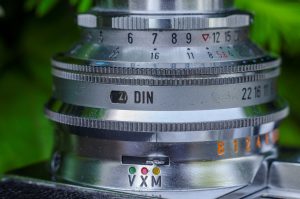
The third letter next to M and X, is a V. I had to look at the user’s manual to discover what “V” meant, and I found out that this is a self timer. This came as quite a surprise to me as it is not obvious that this camera has a self timer just by looking at it. You can only engage the lever in the “V” position after the shutter is cocked. But once you have everything set, focus, shutter speed, aperture, and the shutter is cocked, move the flash sync lever to the V position and press the shutter release. The self timer will start counting down for approximately 8 seconds, at which point the shutter will fire. This has obvious uses for including yourself in the image, or for slow shutter speeds on a tripod without a shutter release cable. Speaking of a shutter release cable, the shutter release is threaded if you wanted to use one.
After shooting a complete roll of film, you need to rewind the film back into the canister using that reversing lever on the side of the camera and turning the rewind knob counterclockwise in the direction of the arrow. Upon fully rewinding the film, you can open the door and remove your exposed film.
During my time shooting with the Vitomatic IIa, I found that it struck the perfect balance of quality “heft” and compactness that didn’t feel cheap or unnecessarily heavy and was easily pocketable. It was easy to use, and the huge viewfinder made shooting with prescription glasses extremely easy and comfortable. I found the unique design of the controls had just the right amount of quirkiness that it wasn’t boring to use. I genuinely enjoyed shooting with the camera, and really hoped that the pleasant experience would translate into excellent images. After all, this is a camera, and no matter how much fun it was in use, it wouldn’t add up to much if the images weren’t any good.
My Results

For my first roll, I took the Vitomatic to northern Michigan to visit my in-laws in mid January. This area of the country is generally overcast, cold, and dreary this time of year, and I’ve learned from experience that it is very difficult to find any vibrant color shots, so I figured the contrast of a good black & white film would better suit my photographic opportunities. For that I chose an expired roll of Fuji Neopan 400 from the early 1990s. Knowing that black & white film generally survives well past it’s expiration date, I thought that this would be a safe bet. Never having shot Neopan before though provided a bit of a risk. How well would the film survive 20+ years of age? How well would it handle the muted color pallet and dreary skies of northern Michigan in the middle of winter? Anytime you use an unknown film with an unknown camera, you take risks because if the results come out poor, you need to differentiate flaws in the film between those from the camera.
After completing the roll, it would take me nearly 4 months to send the film in to get developed to answer these questions. For 4 months the camera sat, on my shelf, waiting for it’s judgement day to come.
Well finally, after what was likely decades between the last time this camera was used before I acquired it, using 20+ year old film, and 4 more months of suspense while I waited to see the results, Judgement Day has come…
These results confirm to me that choosing a black & white film like Fuji Neopan 400 was a wise choice considering the subject matter of my shots. The silvery chrome of the trains, the flakes of rust in the abandoned grain silos, and the dreary and often misty scenes in northern Michigan all played out really well with the Neopan. All of the images exhibit more grain that I would have expected, but then again, this was 20+ year expired film. Upon further analysis of these images, I am extremely pleased with my film choice, and although I very much am excited to see what the Color-Skopar lens is capable of with actual color film, I would have needed to wait months for spring or summer to best take advantage of a vivid color pallet.
The Color-Skopar lens is extremely sharp and shows no vignetting, edge softness, or any other optical anomaly. For as good as my results were, the Color-Skopar isn’t even the “best” lens that could be had with this camera. If you were in the market for a Vitomatic in 1960 and had extra deep pockets, you could get one equipped with the f/2 Ultron. While the Ultron is a more advanced 6-element design, other than the additional stop of exposure, I doubt anyone would be able to detect differences in image quality between shots done with either lens. It is perhaps this reason that finding Vitomatics with the Ultron lens is extremely difficult today. People must have realized that the Color-Skopar lens was good enough to not warrant the extra money.
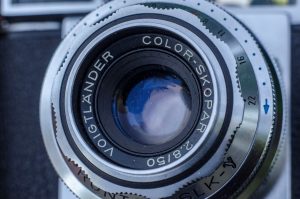
The Vitomatic exceeded every expectation I had for it. Despite the dim rangefinder patch, it clearly did not affect my ability to focus. The Neopan was a 36 exposure roll, and not a single image was out of focus. Even the darker interior shots of the bar and the train are crisply in focus. This is especially impressive considering the 50mm focal length of the lens has less depth of field than the slightly wider 40mm and 44mm lenses used on some rangefinders like the Canonet QL17 and Bolsey B2.
Another pleasant surprise is that the selenium meter is clearly working perfectly. Selenium meters by their very nature will lose sensitivity over time. Sometimes you can prolong the life of a selenium meter by keeping it enclosed in darkness, which is what must have happened as the 57 or so years that have passed since this camera was made have not taken it’s toll yet. I had a few shots that were a tad overexposed, but I attribute that more to me intentionally using +1 exposure due to using 20 year old film. Now that I see what the Neopan is capable of, I will shoot my next roll at box speed and hopefully will get perfectly exposed shots every time.
In the world of photography, Voigtländer needs no introduction. They’re the oldest surviving optics company in the world, they have been instrumental in the design and development of photography in it’s earliest days, and over the course of the past century, have made some of the best cameras and lenses ever created. Yet, it is clear that even their more “pedestrian” models were still built with amazing quality, and I find it strange that more is not talked about models like the Vitomatic. The fact that I picked this up for only $10 represents one of the best bargains of any camera in my collection.
It might not have the panache or reputation of models made by Leica or Zeiss, and it might not even have the desirability of other Voigtländer cameras like the Bessa or the Prominent, but the Voigtländer Vitomatic IIa is one hell of a camera. Even if you were to find one in less than ideal condition, with a dead meter, or a hazy rangefinder patch, this is absolutely a camera worth picking up. I knew from the moment I picked it up that it was a special camera, from it’s excellent design, monstrous viewfinder, great looks, and fun quirks, but now that I’ve seen what kinds of images it is capable of, this camera is elevated even further in my mind as one of the best cameras in my collection. I absolutely cannot wait to use it again!
My Final WordHow these ratings work |
The Voigtländer Vitomatic IIa was a popular rangefinder built in the early 1960s and was a popular alternative to much more expensive German made rangefinders. The built quality, ergonomics, and lens of the camera are excellent. The viewfinder is one of the largest I’ve ever seen and extremely easy to use with prescription glasses. It has a very useful meter that is visible in the viewfinder which was not common when this camera was introduced. The Color-Skopar lens is capable of extremely high detail images, and with a working meter and accurate rangefinder, you can capture some extremely good images with this camera. There is absolutely no reason this shouldn’t be a more desirable camera by collectors, but somehow, it has slipped through the cracks and is relatively unnoticed in the used market. I was able to find this camera for pocket change, but it is worth so much more. I absolutely loved my time with this camera, and was extremely pleased with it’s results. I highly recommend picking up this camera if you have the opportunity. | ||||||
| Images | Handling | Features | Viewfinder | Feel & Beauty | History | Age | |
| 2 | 2 | 1 | 2 | 2 | 0 | 20% | |
| Bonus | +1 for overall excellence, the complete package, this is one hell of a camera | ||||||
| Final Score | 11.8 | ||||||
Additional Resources
http://camera-wiki.org/wiki/Vitomatic_IIa
http://www.collection-appareils.fr/x/html/page_standard.php?id_appareil=11759
http://www.photoethnography.com/ClassicCameras/index-frameset.html?VoigtlanderVitomatic.html
https://www.lomography.com/magazine/180395-in-love-with-an-antique-cutie-voigtlander-vitomatic-ii
http://www.amateurphotographer.co.uk/forums/threads/voigtl%C3%A4nder-vitomatic-iia.114174/

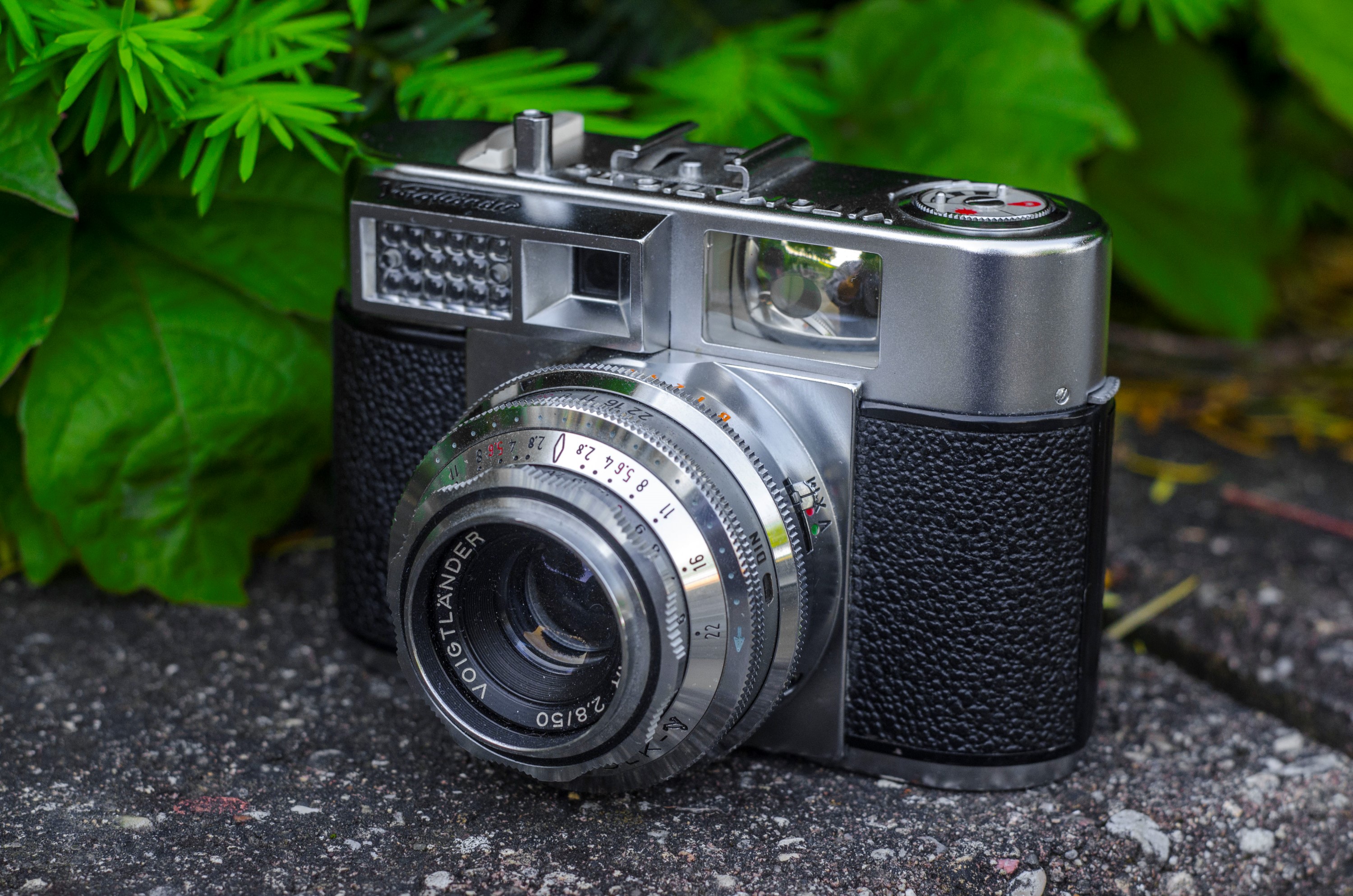
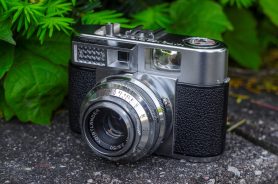
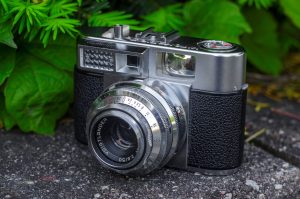
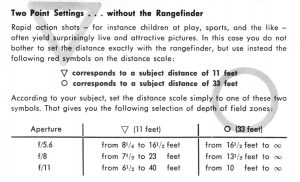












Dear Mike,
thank you for your detailed camera reviews!
It is relatively easy and secure to clean the range finder once you removed the top plate, I’ve done this for some of the Vitomatics: just remove the light meter block and the chrome frame. Look for all the glass surfaces in the light path (sometimes the glued square front glass behind the small window of the chrome frame gets loose, which makes cleaning easier through the round window; it has to be glued again afterwards). Use a match or a tooth pick covered with some cotton batting and immersed with alcohol or so to clean the surfaces.
Regards
Oliver
Great review, thank you. I’ve got a Vitomatic but with the f2.8 Lanther lens. I bought it in an antique store in Kansas City, if memory serves. I’ve shot a few rolls with it and am pleased with the results. Mine is strictly a zone focus model, it must have been the low end of this line. I’ve also got a Voigtlander Bessa II 6×9 with a Color Heliar f3.5. It produces superb images and is one of my favorites.
This is a delightful camera. I have two – this one and the later Vitomatic IICS. I also have the earlier Vito B and Vito BL which were the precursors of the Vitomatic in the 1950s.
The voigtlander cameras are probably my favourites of all my old cameras.
Great review. Thank you, a job well done.
I obtained a Vito IIa last week which I intend to run a roll of Tri-x 400 through it today. After reading your very nice review I can’t wait to put it to the test.
Great review Mike.
Very nice photos! Colour is just as good from my experience.
I have this model and inherited a Vito C. Both take exceptional pictures and I love the solid feel, quality construction and cute everready cases that generally come with and protect them. There are also some fine filter and lens shade accessories for them.
The Vitomatic being a rangefinder is by far my preferred camera, however the Vito C is overall a little bigger and I prefer its feel in the hand.
They are very fun to use and far quieter than any other camera I own, save my Olympus OMD EM1 with electric shutter turned on. Quieter than a Leica!
Sixty years and going strong…….not bad at all….I doubt any digital cameras will get half that life.
BTW. I tried cleaning the rangefinder patch path, but the glass was stuck on too well and is brittle around the edges, so be very careful if you try to remove the glass plate cover.
Regards
Tony
Great review! I have a Vito CLR. Not sure where it fits in the development cycle of Vito cameras, but it has the top-mounted meter. The viewfinder is large and bright, and all the shutter speeds sound correct, to my ear. Aperture is great and rangefinder is clear. Only thing that’s DOA on mine is the selenium light meter. Mine even came with a roll of ASA 100 b&w film. No idea how old it is!
Hi
Love all the info on this Beautiful old camera
In today’s market what do you think is the value of this camera, with the leather case attached?
Thanks for the feedback, Dawn. In terms of valuating your camera, there are a bunch of variables, so I recommend checking out this article.
https://mikeeckman.com/2020/02/what-is-my-camera-worth/
I got a iia with ultron earlier this year and the shooting experience is so great. Just noticed that it is that rare – 6,000/200,000!
Hello, i found multiple IIas on eBay and a lot of them have damaged mirror-coating in the viewfinder. Is that a big problem? How will it affect the image seen through the viewfinder?
Best regards
Linus
Linus, the Vitomatic IIa does not use mirrors, it has a prism to reflect the image from the rangefinder into the main viewfinder. If the reflective coating becomes damaged, the rangefinder will be difficult, or even impossible to see, but it should not affect your ability to use the viewfinder. You’ll be able to compose your image, just not see the coincident image. You’d need to scale focus the camera as if it had no rangefinder, but would otherwise work OK.
2 years ago I bought myself as a birthday present gorgeous Kodak No.2 with compound shutter. I got curious and wanted to shoot with it, but struggle with adapters and masking off chamber were not worth it. So I started looking for something more usable and locally bought this camera. Same lens, only there is no flash/selftimer lever, just selftimer. Best word for desceibing this camera is DENSITY. So much features and weight packed in such a small camera.
I had learned how to get through lens to shutter and relube those damn small cogs making delay for longer speeds. I got it together and it makes really lovely photographs. Meter on mine is also working and sadly the rangefinder patch is also not wery clear which is limiting its use in low light situations. So it is summer camera for sunny trips.
After Vitomatic I had discovered Ihagee Exakta and fell in love. Now I have nearly two dozens of them, all of them from postwar Kine to RTL. Beaten and also by myself repaired Exakta Varex VX is now my primary instrument to catch memories through biotar onto black and white film. I love the sounds and feeling of that camera.
To complete the list, there is 35 mm Prominent with Ultron lens. Rangefinder is clear amd camera is fun to use, but Vitomatic is faster and better camera to shoot with. 10 years of evolution…
From this point, german photo industry faced hard truth of Japan superiority and cameras become plasticky and finicky and for us unenjoyable.
When I hold my Vitomatic IIa I always think about it as a one of peaks of german photo industry. Little marvelous camera. If anyone got the chance to get one, go for it. It is really joy to use, beauty to look at and when someone should face intruder in his house, this camera can be surely used as a hammer to knock the man down. And after that will be still ready for next roll of film.